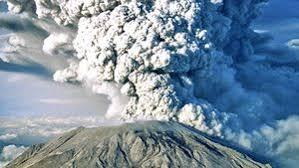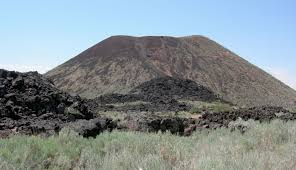A shield volcano is a type of volcano named for its low profile, resembling a warrior's shield lying on the ground. It is formed by the eruption of highly fluid (low viscosity) lava, which travels farther and forms thinner flows than the more viscous lava erupted from a stratovolcano. Repeated eruptions result in the steady accumulation of broad sheets of lava, building up the shield volcano's distinctive form. The term 'shield volcano' is taken from the German term Schildvulkan, coined by the Austrian geologist Eduard Suess in 1888 and which had been calqued into English by 1910.
Shield volcanoes are found wherever fluid low-silica lava reaches the surface of a rocky planet. However, they are most characteristic of ocean island volcanism associated with hot spots or with continental rift volcanism. They include the largest volcanoes on earth, such as Tamu Massif and Mauna Loa. Giant shield volcanoes are found on other planets of the Solar System, including Olympus Mons on Mars and Sapas Mons on Venus.
Structure
Shield volcanoes are distinguished from the three other major volcanic types-stratovolcanoes, lava domes, and cinder cones-by their structural form, a consequence of their particular magmatic composition. Of these four forms, shield volcanoes erupt the least viscous lavas. Whereas stratovolcanoes and lava domes are the product of highly viscous flows, and cinder cones are constructed of explosively eruptive tephra, shield volcanoes are the product of gentle effusive eruptions of highly fluid lavas that produce, over time, a broad, gently sloped eponymous "shield". Although the term is generally applied to basaltic shields, it has also at times been applied to rarer scutiform volcanoes of differing magmatic composition-principally pyroclastic shields, formed by the accumulation of fragmental material from particularly powerful explosive eruptions, and rarer felsic lava shields formed by unusually fluid felsic magmas. Examples of pyroclastic shields include Billy Mitchell volcano in Papua New Guinea and the Purico complex in Chile; an example of a felsic shield is the Ilgachuz Range in British Columbia, Canada. Shield volcanoes are similar in origin to vast lava plateaus and flood basalts present in various parts of the world. These are eruptive features which occur along linear fissure vents and are distinguished from shield volcanoes by the lack of an identifiable primary eruptive center.
Active shield volcanoes experience near-continuous eruptive activity over extremely long periods of time, resulting in the gradual build-up of edifices that can reach extremely large dimensions. With the exclusion of flood basalts, mature shields are the largest volcanic features on Earth. The summit of the largest subaerial volcano in the world, Mauna Loa, lies 4,169 m above sea level, and the volcano, over 60 mi (100 km) wide at its base, is estimated to contain about 80,000 km3 of basalt. The mass of the volcano is so great that it has slumped the crust beneath it a further 8 km. Accounting for this subsidence and for the height of the volcano above the sea floor, the "true" height of Mauna Loa from the start of its eruptive history is about 17,170 m. Mount Everest, by comparison, is 8,848 m in height. In September 2013, a team led by the University of Houston's William Sager announced the discovery of Tamu Massif, an enormous extinct submarine shield volcano of previously unknown origin which, approximately 450 by 650 km in area, dwarfs all previously known volcanoes on the planet. However, the extents of the volcano have not been confirmed.
Shield volcanoes feature a gentle (usually 2° to 3°) slope that gradually steepens with elevation (reaching approximately 10°) before flattening near the summit, forming an overall upwardly convex shape. In height they are typically about one twentieth their width. Although the general form of a "typical" shield volcano varies little worldwide, there are regional differences in their size and morphological characteristics. Typical shield volcanoes found in California and Oregon measure 3 to 4 mi (5 to 6 km) in diameter and 500 to 600 m in height, while shield volcanoes in the central Mexican Michoacán-Guanajuato volcanic field average 340 m in height and 4,100 m in width, with an average slope angle of 9.4° and an average volume of 1.7 km3.
Rift zones are a prevalent feature on shield volcanoes that is rare on other volcanic types. The large, decentralized shape of Hawaiian volcanoes as compared to their smaller, symmetrical Icelandic cousins[8] can be attributed to rift eruptions. Fissure venting is common in Hawaiʻi; most Hawaiian eruptions begin with a so-called "wall of fire" along a major fissure line before centralizing to a small number of points. This accounts for their asymmetrical shape, whereas Icelandic volcanoes follow a pattern of central eruptions dominated by summit calderas, causing the lava to be more evenly distributed or symmetrical.
Eruptive characteristics
Most of what is currently known about shield volcanic eruptive character has been gleaned from studies done on the volcanoes of Hawaiʻi Island, by far the most intensively studied of all shields because of their scientific accessibility; the island lends its name to the slow-moving, effusive eruptions typical of shield volcanism, known as Hawaiian eruptions. These eruptions, the least explosive of volcanic events, are characterized by the effusive emission of highly fluid basaltic lavas with low gaseous content. These lavas travel a far greater distance than those of other eruptive types before solidifying, forming extremely wide but relatively thin magmatic sheets often less than 1 m thick. Low volumes of such lavas layered over long periods of time are what slowly constructs the characteristically low, broad profile of a mature shield volcano.
Also unlike other eruptive types, Hawaiian eruptions often occur at decentralized fissure vents, beginning with large "curtains of fire" that quickly die down and concentrate at specific locations on the volcano's rift zones. Central-vent eruptions, meanwhile, often take the form of large lava fountains (both continuous and sporadic), which can reach heights of hundreds of meters or more. The particles from lava fountains usually cool in the air before hitting the ground, resulting in the accumulation of cindery scoria fragments; however, when the air is especially thick with pyroclasts, they cannot cool off fast enough because of the surrounding heat, and hit the ground still hot, accumulating into spatter cones. If eruptive rates are high enough, they may even form splatter-fed lava flows. Hawaiian eruptions are often extremely long-lived; Puʻu ʻŌʻō, a cinder cone of Kīlauea, erupted continuously from January 3, 1983, until April 2018.
Flows from Hawaiian eruptions can be divided into two types by their structural characteristics: pāhoehoe lava which is relatively smooth and flows with a ropey texture, and ʻaʻā flows which are denser, more viscous (and thus slower moving) and blockier. These lava flows can be anywhere between 2 and 20 m thick. ʻAʻā lava flows move through pressure-the partially solidified front of the flow steepens because of the mass of flowing lava behind it until it breaks off, after which the general mass behind it moves forward. Though the top of the flow quickly cools down, the molten underbelly of the flow is buffered by the solidifying rock above it, and by this mechanism, ʻaʻā flows can sustain movement for long periods of time. Pāhoehoe flows, in contrast, move in more conventional sheets, or by the advancement of lava "toes" in snaking lava columns. Increasing viscosity on the part of the lava or shear stress on the part of local topography can morph a pāhoehoe flow into an ʻaʻā one, but the reverse never occurs.
Although most shield volcanoes are by volume almost entirely Hawaiian and basaltic in origin, they are rarely exclusively so. Some volcanoes, such as Mount Wrangell in Alaska and Cofre de Perote in Mexico, exhibit large enough swings in their historical magmatic eruptive characteristics to cast strict categorical assignment in doubt; one geological study of de Perote went so far as to suggest the term "compound shield-like volcano" instead. Most mature shield volcanoes have multiple cinder cones on their flanks, the results of tephra ejections common during incessant activity and markers of currently and formerly active sites on the volcano. An example of these parasitic cones is at Puʻu ʻŌʻō on Kīlauea-continuous activity ongoing since 1983 has built up a 698 m tall cone at the site of one of the longest-lasting rift eruptions in known history.
The Hawaiian shield volcanoes are not located near any plate boundaries; the volcanic activity of this island chain is distributed by the movement of the oceanic plate over an upwelling of magma known as a hotspot. Over millions of years, the tectonic movement that moves continents also creates long volcanic trails across the seafloor. The Hawaiian and Galápagos shields, and other hotspot shields like them, are constructed of oceanic island basalt. Their lavas are characterized by high levels of sodium, potassium, and aluminium.
Features common in shield volcanism include lava tubes. Lava tubes are cave-like volcanic straights formed by the hardening of overlaying lava. These structures help further the propagation of lava, as the walls of the tube insulate the lava within. Lava tubes can account for a large portion of shield volcano activity; for example, an estimated 58% of the lava forming Kīlauea comes from lava tubes.
In some shield volcano eruptions, basaltic lava pours out of a long fissure instead of a central vent, and shrouds the countryside with a long band of volcanic material in the form of a broad plateau. Plateaus of this type exist in Iceland, Washington, Oregon, and Idaho; the most prominent ones are situated along the Snake River in Idaho and the Columbia River in Washington and Oregon, where they have been measured to be over 2 km in thickness.
Calderas are a common feature on shield volcanoes. They are formed and reformed over the volcano's lifespan. Long eruptive periods form cinder cones, which then collapse over time to form calderas. The calderas are often filled up by progressive eruptions, or formed elsewhere, and this cycle of collapse and regeneration takes place throughout the volcano's lifespan.
Interactions between water and lava at shield volcanoes can cause some eruptions to become hydrovolcanic. These explosive eruptions are drastically different from the usual shield volcanic activity and are especially prevalent at the waterbound volcanoes of the Hawaiian Isles.












No comments:
Post a Comment